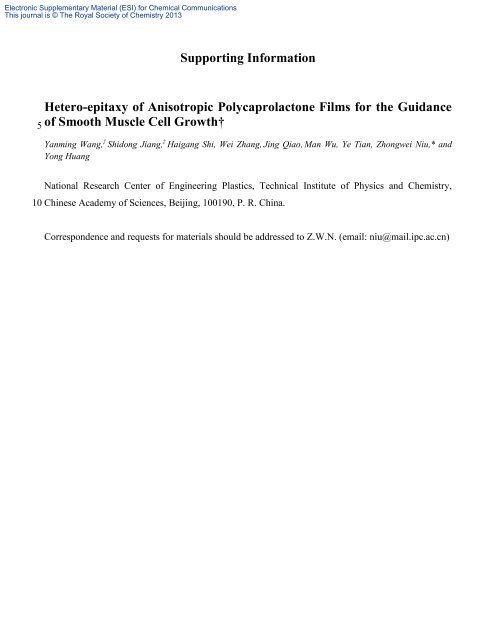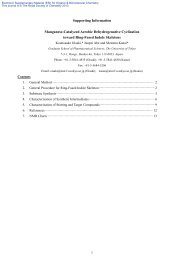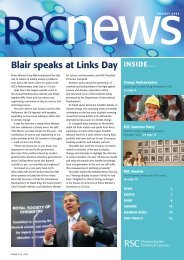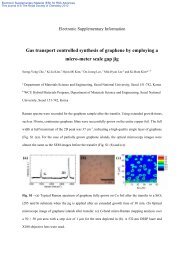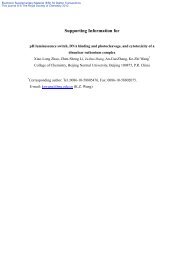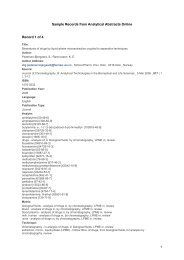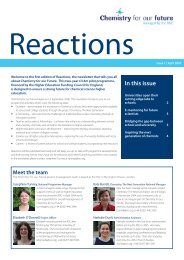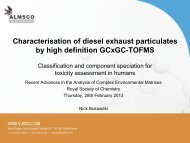Supporting Information Hetero-epitaxy of Anisotropic ...
Supporting Information Hetero-epitaxy of Anisotropic ...
Supporting Information Hetero-epitaxy of Anisotropic ...
You also want an ePaper? Increase the reach of your titles
YUMPU automatically turns print PDFs into web optimized ePapers that Google loves.
Electronic Supplementary Material (ESI) for Chemical Communications<br />
This journal is © The Royal Society <strong>of</strong> Chemistry 2013<br />
<strong>Supporting</strong> <strong>Information</strong><br />
<strong>Hetero</strong>-<strong>epitaxy</strong> <strong>of</strong> <strong>Anisotropic</strong> Polycaprolactone Films for the Guidance<br />
5 <strong>of</strong> Smooth Muscle Cell Growth†<br />
Yanming Wang, ‡ Shidong Jiang, ‡ Haigang Shi, Wei Zhang, Jing Qiao, Man Wu, Ye Tian, Zhongwei Niu,* and<br />
Yong Huang<br />
National Research Center <strong>of</strong> Engineering Plastics, Technical Institute <strong>of</strong> Physics and Chemistry,<br />
10 Chinese Academy <strong>of</strong> Sciences, Beijing, 100190, P. R. China.<br />
Correspondence and requests for materials should be addressed to Z.W.N. (email: niu@mail.ipc.ac.cn)
Electronic Supplementary Material (ESI) for Chemical Communications<br />
This journal is © The Royal Society <strong>of</strong> Chemistry 2013<br />
Experimental details<br />
Materials<br />
Polycaprolactone (PCL, M n 70 000 ~ 90 000 g mol -1 ) was obtained from Sigma-Aldrich (Shanghai)<br />
Trading Company. Chlor<strong>of</strong>orm was purchased from Beijing Chemical Works, which was purified by<br />
5 molecular sieve dehydration before use. Other organic reagents, glass plates and glass tubes were<br />
bought from Beijing Chemical Works.<br />
Fabrication <strong>of</strong> composite PCL/PTFE films<br />
The glass plates or glass tubes were first successively cleaned with pure water, hot acetone, hot<br />
concentrated sulfuric acid-hydrogen peroxide solution (concentrated sulfuric acid/hydrogen peroxide =<br />
10 2:1), pure water, and pure ethanol.<br />
To prepare well aligned thin films <strong>of</strong> highly aligned PTFE, the friction-deposition technique was<br />
utilized. Before rubbing, the friction surface <strong>of</strong> PTFE rod was fully polished by 1200 mesh sand paper.<br />
To rub a glass plate, a PTFE rod with the diameter <strong>of</strong> 20 mm and the length <strong>of</strong> 5 cm was used. The<br />
deposition was performed at a velocity <strong>of</strong> 10 mm/s, a temperature <strong>of</strong> 280 °C, and an applied pressure<br />
15 <strong>of</strong> 0.5 MPa. To rub a glass tube (diameter 8 mm, length 4 cm), the home-made PTFE rod (a quarter <strong>of</strong><br />
PTFE rod with the length 8 cm) with the same curvature radius <strong>of</strong> 8 mm as the glass tube was used.<br />
The rubbing was performed at a velocity <strong>of</strong> 10 mm/s, a temperature <strong>of</strong> 280 °C, and an applied pressure<br />
<strong>of</strong> around 0.5 MPa with the home-made PTFE rod at a tilt angle <strong>of</strong> 2º. It should be noted that the<br />
temperature and pressure could not be controlled as well as on flat surface when rubbing inside the<br />
20 tube. After self-cooling into room temperature, the glass substrates or glass tubes with aligned PTFE<br />
were immersed into the PCL solution (about 0.01 g mL -1 in chlor<strong>of</strong>orm) for 1 minute and then pulled<br />
out. After evaporation <strong>of</strong> solvent, the thin anisotropic PCL films were formed on the oriented PTFE
Electronic Supplementary Material (ESI) for Chemical Communications<br />
This journal is © The Royal Society <strong>of</strong> Chemistry 2013<br />
surface. The composite PCL/PTFE films were then further annealed at 55 °C for 2 hours to improve<br />
the epitaxial crystallinity <strong>of</strong> the PCL.<br />
Cell Culture<br />
The glass slides with composite PCL/PTFE films were cut into rectangular pieces with size <strong>of</strong> 1cm × 1<br />
5 cm, and sterilized by exposing to UV light for 1 hour in a clean hood. The glass tubes were cut into 1<br />
cm in length for easy cell culture. The distance between the UV source and the samples was 30 cm.<br />
The samples were placed at the bottom <strong>of</strong> 12-well cell-culture plate followed by being soaked<br />
incomplete medium (high Glucose DMEM (Hyclone) supplemented with 10% calf serum (Gibco) and<br />
1% <strong>of</strong> penicillin and streptomycin sulphate (Solarbio)) for 24 h. Fibroblast-like L929 cells (mouse<br />
10 fibroblast cell line), rabbit vessel smooth muscle cells (SMCs), bone marrow mesenchymal stem cells<br />
(BMMSCs) and Chinese hamster ovary cells (CHO), all obtained from Cell Resource Center (IBMS,<br />
CAMS/PUMC), were cultured on different substrates in cell-culture plate. Cells were seeded on the<br />
samples after the fresh medium being changed, and incubated at 37 °C in the atmosphere <strong>of</strong> 5% CO 2<br />
overnight. Fresh medium was replenished according to the color indicator in all cultures.<br />
15 Cell alignment statistical method<br />
The percentage <strong>of</strong> cell alignment <strong>of</strong> SMCs cultured on composite PCL/PTFE films was statistically<br />
measured. The angle between the long axis <strong>of</strong> a cell and the direction <strong>of</strong> the rubbing was defined as the<br />
cell orientation angle. The rubbing direction was set as 0 o . About 300 <strong>of</strong> SMCs fixed after 3 days’<br />
culturing were measured against the orientation angle. The cells were considered to be aligned with the<br />
20 substrate patterns when the cell orientation angle was less than 15 o .<br />
Real-time polymerase chain reaction (PCR)<br />
The SMCs were seeded on various substrates (composite PCL/PTFE films as the experiment group,<br />
and pure PCL films as the contrast group) and cultured for 2, 5, 7 days respectively. The total RNA
Electronic Supplementary Material (ESI) for Chemical Communications<br />
This journal is © The Royal Society <strong>of</strong> Chemistry 2013<br />
was extracted with Trizol (Invitrogen, USA). Total RNA was converted to cDNA using the<br />
PrimeScript ® RT reagent kit (TaKaRa, Japan). In order to evaluate the gene expression <strong>of</strong> the alpha<br />
smooth muscle actin (α-SMA) and osteopontin (OPN), the Real-time PCR reactions were performed<br />
using SYBR ® Green assay (TaKaRa, Japan) on the Fast 7500 ® Real-time PCR System (ABI, USA).<br />
5 Glyceraldehyde-3-phosphate dehydrogenase (GAPDH), as a housekeeping gene, was used as<br />
endogenous normalization controls for protein-encoding genes. The primers are listed in Table 1.<br />
Table 1.The primer sequences used in the experiment were as follows. Note: all primers are the same<br />
for rabbit vessel SMCs.<br />
Genes Forward Primer Sequence (5’-3’) Reverse Primer Sequence (5’-3’)<br />
α-SMA TGTACCCTGGCATTGCTGACCG TGTGGGCTAGAAACAGAGCAGGG<br />
OPN CCACACGCCGACCAAGGAACAA AGCTGCCCGAATCAGCGTGT<br />
GAPDH CTTCAACAGTGCCACCCACTCCTCT TGAGGTCCACCACCCTGTTGCTGT<br />
10
Electronic Supplementary Material (ESI) for Chemical Communications<br />
This journal is © The Royal Society <strong>of</strong> Chemistry 2013<br />
Characterizations<br />
Morphology detections<br />
Tapping mode atomic force microscopy (AFM) images were obtained at ambient conditions using a<br />
5 Bruker, Multimode 8 AFM. Si tip with a resonance frequency <strong>of</strong> approximately 300 kHz, a spring<br />
constant <strong>of</strong> about 40 N m -1 , and a scan rate <strong>of</strong> 0.8 Hz was used. The orientation <strong>of</strong> the samples was<br />
investigated by polarized optical microscope (POM, Olympus BH-2). The morphology <strong>of</strong> samples<br />
after sputter-coated with gold palladium for 60 s were characterized using a JEOL S-4300 field<br />
emission scanning electron microscope (FE-SEM) operated at an accelerating voltage <strong>of</strong> 10 kV.<br />
10 Fluorescence staining and imaging<br />
Samples were washed twice (10 min per time) with 0.1 M sterilized phosphate buffered saline (pH 7.2,<br />
PBS) at room temperature, followed by being fixed in 4% paraformaldehyde for 30 min, and washed<br />
three times with PBS. Then, the α-actin <strong>of</strong> cells was stained with FITC-Phalloidin (Sigma-Aldrich) and<br />
incubated for 1 h, and the nucleus was stained with DAPI (Sigma-Aldrich) for 10 min. Samples were<br />
15 thoroughly washed three times with PBS, and the glycerol/PBS mounting medium was added to the<br />
samples before inspection with fluorescence microscope (Observer D1, Carl Zeiss). All the microscope<br />
settings were the same, in which the exposure time was 245 ms.
Electronic Supplementary Material (ESI) for Chemical Communications<br />
This journal is © The Royal Society <strong>of</strong> Chemistry 2013<br />
Figures<br />
Figure S1. AFM phase (a, b) and height (c, d) images <strong>of</strong> (left) friction-transferred single PTFE layer<br />
and (right) composite PCL/PTFE films on glass substrate, and their corresponding cross-section<br />
5 pr<strong>of</strong>iles (e, f), respectively. SEM images <strong>of</strong> single friction-transferred PTFE layer (g) and composite<br />
PCL/PTFE films on glass substrate (h). The arrows indicate the sliding direction <strong>of</strong> PTFE on glass<br />
substrate.
Electronic Supplementary Material (ESI) for Chemical Communications<br />
This journal is © The Royal Society <strong>of</strong> Chemistry 2013<br />
5 Figure S2. POM images <strong>of</strong> the sample under crossed polarizers, the anticlockwise ratation angle to the<br />
beam axis in which is 0° (a) and 45° (b), respectively. The white dashed line indicates the boundary.<br />
Top part is the PCL crystallized on glass substrate (pure PCL films) and bottom part is the PCL<br />
crystallized on the PTFE surface (composite PCL/PTFE films). The arrows indicate the rubbing<br />
direction.<br />
10
Electronic Supplementary Material (ESI) for Chemical Communications<br />
This journal is © The Royal Society <strong>of</strong> Chemistry 2013<br />
Large area characterization <strong>of</strong> the PCL/PTFE film<br />
We selected couple areas to perform large (50 μm× 50 μm) area characterization <strong>of</strong> the PCL/PTFE<br />
film by AFM. As shown a typical AFM height image below (Fig S3), the whole film was very<br />
homogenous with surface roughness 8.54 nm and the height difference around 40 nm. These data were<br />
5 added in the revised manuscript. Furthermore, the composite PCL/PTFE film was also checked by the<br />
TEM-EDAX, and the selected area electron diffraction pattern (Fig. S4) also indicates that the whole<br />
film had the highly homogeneous structure.<br />
10um<br />
10 Figure S3. Large scale AFM height image <strong>of</strong> the composite PCL/PTFE film and the corresponding<br />
cross-section pr<strong>of</strong>ile.
Electronic Supplementary Material (ESI) for Chemical Communications<br />
This journal is © The Royal Society <strong>of</strong> Chemistry 2013<br />
(0014) PCL<br />
(0013) PTFE<br />
Figure S4. Selected area electron diffraction pattern <strong>of</strong> the composite PCL/PTFE film.
Electronic Supplementary Material (ESI) for Chemical Communications<br />
This journal is © The Royal Society <strong>of</strong> Chemistry 2013<br />
Isotropic PCL film<br />
The isotropic PCL film on the glass slide with random grown spherulites was employed as the<br />
reference. As shown in Fig. S5, sperulites with diameter around 50 μm are randomly grown on the<br />
glass slide.<br />
a<br />
5<br />
50μm<br />
b<br />
c<br />
10μm<br />
1μm<br />
Figure S5. (a) POM micrograph <strong>of</strong> single PCL film, (b) AFM height image <strong>of</strong> a spherulite on single<br />
PCL film and (b) the zoom-in AFM height image as marked in part (a).<br />
10
Electronic Supplementary Material (ESI) for Chemical Communications<br />
This journal is © The Royal Society <strong>of</strong> Chemistry 2013<br />
Stability test <strong>of</strong> the film<br />
The stability <strong>of</strong> the composite films was tested by treating samples under ultrasonication in PBS for 5<br />
min and incubation in PBS for 2 weeks. As shown in Figure S6b and c, after ultrasonication and<br />
5 incubation, the surface <strong>of</strong> thin film still maintained the similar morphology as untreated sample (Figure<br />
S6a). Furthermore, their corresponding cross-section pr<strong>of</strong>iles (Figure S6d, S6e and S6f) clearly show<br />
only slight difference <strong>of</strong> height <strong>of</strong> treated samples with untreated samples. The surface roughness for<br />
these samples is very similar, which is 8.54 nm for untreated sample, 10.6 nm for ultrasonication<br />
sample, 10.0 nm for incubation sample, respectively. These results illustrate that the composite<br />
10 PCL/PTFE films were very stable in PBS for at least 2 weeks.<br />
a b c<br />
d e f<br />
Figure S6. AFM height images <strong>of</strong> (a) untreated PCL/PTFE thin film, (b) after ultrasonication in PBS<br />
for 5 min and (c) after incubation in PBS for 2 weeks. (d), (e) and (f) are corresponding cross section<br />
15 pr<strong>of</strong>iles <strong>of</strong> (a), (b) and (c).
Electronic Supplementary Material (ESI) for Chemical Communications<br />
This journal is © The Royal Society <strong>of</strong> Chemistry 2013<br />
Rubbing the glass tube<br />
As shown in the Scheme S1, to rub a glass tube, the home-made PTFE rod with the same curvature<br />
radius <strong>of</strong> 8 mm as the glass tube was used. The rubbing was performed manually at a velocity <strong>of</strong> 10<br />
mm/s, a temperature <strong>of</strong> 280 °C, and an applied pressure <strong>of</strong> around 0.5 MPa with the home-made PTFE<br />
5 rod at a tilt angle <strong>of</strong> 2º. It should be noted that the temperature and pressure could not be controlled as<br />
well as on flat surface when rubbing inside the tube.<br />
Scheme S1. Schematic illustration <strong>of</strong> rubbing the glass tube by a PTFE rod.<br />
10
Electronic Supplementary Material (ESI) for Chemical Communications<br />
This journal is © The Royal Society <strong>of</strong> Chemistry 2013<br />
Figure S7. The FM merged images <strong>of</strong> various cells on composite PCL/PTFE films. (a) L929 cells<br />
were cultured for 3 days. (b) BMMSCs were cultured for 7 days. (c) CHO cells were cultured on<br />
5 curved composite PCL/PTFE films for 7 days. Arrows indicate the PTFE rubbing direction.


